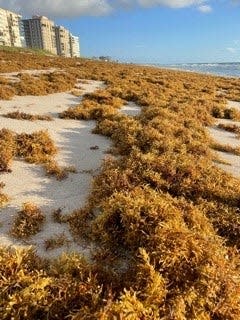Seaweed is good for the environment, except when nutrients cause massive algal blooms
People may find the massive amounts of seaweed washing up on Florida beaches to be smelly, annoying and even unhealthy, but not much can be done about it right now.
Mechanical removal of the algae clumps that typically wash ashore from April to September is prohibited during sea turtle nesting season, from March 1 to Oct. 31. Hand-raking can be environmentally damaging too, only on a smaller scale.
The South Atlantic Fishery Management Council outlawed harvesting seaweed from the Great Atlantic Sargassum Belt in offshore waters because it provides habitat for fish, such as tripletail, blackfin tuna and dolphin, more commonly called mahi-mahi.
So while you tiptoe around the mounds on the beach and swim through acres of algae in the water this summer, contemplate these facts about sargassum seaweed:
Video: "Dr. Beach" says seaweed problem begins in Brazil
Top secret: Jensen agar production plant was hush-hush in 1940s
Photo gallery: Best beaches for shelling, surfing, sunning, seclusion

Where does the seaweed come from?
"Gulfweed" or "sea holly," as it's sometimes called, originates in the Sargasso Sea. Currents push it south, then east, either into the Caribbean Sea, the Gulf Stream or the Gulf of Mexico. The Gulf Stream carries it north, unless stronger east winds drive it onshore. The rest circles the Atlantic until it sinks and dies in the Sargasso Sea.
Is there anything good about seaweed?
In moderation, it has many environmental benefits, such as holding beach sand in place and providing food, fertilizer, hide-out habitat and nest-building materials for a vast array of wildlife, including birds, crabs, young turtles and dune plants. However, blooms have been increasing to problematic sizes over the past decade.
What does seaweed eat to make such massive blooms?
The algae feeds on nitrogen and phosphorus in sewage discharges and stormwater runoff from the Congo, Amazon and Mississippi rivers; equatorial upwelling; vertical mixing; vegetation burning and even windblown grains of sand from the Sahara Desert.
Can it be as bad for the environment as it is good?
When it gorges on such nutrients, it can become toxic for wildlife. Excessive blooms can smother sea turtle nests, impede mothers from nesting and deplete the water of oxygen, which can kill fish, sea turtles and seagrasses that animals eat.
Why do anglers hate seaweed?
It impedes surf fishing. Anglers from Jacksonville to Jupiter say they haven't been able to catch snook, pompano or whiting from the beaches for the past three weeks.
Why do boaters hate seaweed?
It can get tangled in boat propellers and sucked into the engines of personal watercraft.
Is seaweed dangerous for people?
It can contain high levels of arsenic and other heavy metals, so best not touch it, much less eat it, though some do. A 2014 article in Pharmacognosy Reviews says it's a "nutritious and rich source of bioactive compounds such as vitamins, carotenoids, dietary fibers, proteins and minerals." Eattheweeds.com says it's an acquired taste.
It isn't toxic to touch, but touching some of the organisms living in it can cause skin rashes or blisters. The most prevalent are tiny jellyfish larvae, commonly called "sea lice." Seaweed also attracts insects that can bite or sting.
The rotten egg smell comes from the hydrogen sulfide produced as it rots in the sun. "There can be some pretty serious health risks," said Brian Lapointe, a research professor at Florida Atlantic University's Harbor Branch Oceanographic Institute in Fort Pierce. Low levels can irritate the eyes, nose and throat. High levels can cause headaches, poor memory, tiredness and balance problems. People with asthma and other respiratory conditions should leave the beach when symptoms begin.
Is the problem getting worse every year?
Large amounts of seaweed have appeared in the Caribbean Sea every summer since 2011, except in 2013, according to the University of South Florida's Optical Oceanography Lab. A record 24.2 million tons was documented in June 2022.
Compiled from previous articles by reporters Tyler Treadway, Ed Killer and Jim Waymer.
This article originally appeared on Treasure Coast Newspapers: Seaweed plagues Florida beaches. 10 things to know about the algae
